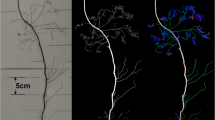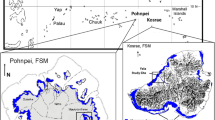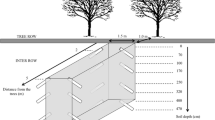Abstract
Using minirhizotrons, fine root dynamics were compared in two Atlantic white-cedar swamps with contrasting hydroperiods (intermittently and persistently flooded) in order to evaluate the effects of flooding regime on fine root depth, abundance, production, and longevity. Despite the higher mean watertable depth in the persistently flooded, site, no differences in rooting depth were observed. Root length density, root abundance, and root longevity were generally greater in the persistently flooded site throughout the 439-day study period, although root length production was similar between the two sites. These results suggest that prolonged inundation in Atlantic white-cedar swamps decreases root elongation rates, but due to greater observed root densities, stand-level belowground production remains similar to that of intermittently flooded stands. Significant increases in root mortality were observed in the intermittently flooded side during a period of water-table drawdown, suggesting less than optimal hydrologic conditions at this site.
Similar content being viewed by others
Literature cited
Baker, T. T., W. H. Conner, B. G. Lockaby, J. A. Stanturf, and M. K. Burke. 2001. Fine root productivity and dynamics on a forested floodplain in South Carolina. Soil Science Society of America Journal 65:545–556.
Bartsch, N. 1987. Response of root systems of youngPinus slyvestris andPicea abies plants to water deficits and soil acidity. Canadian Journal of Forest Research 17:805–812.
Boogie, R. 1972. Effect of high water table on root development ofPinus cornata on a deep peat in Scotland. Oikos 23:304–312.
Brown, D. A. and R. B. Atkinson. 1999. Assessing survivability and growth of Atlantic white cedar [Chamaecyparis thyoides (L.) B.S.P.] in the Great Dismal Swamp National Wildlife Refuge. p.1–7.In T. Shear and K. O. Summerville (eds.) Atlantic White Cedar: Ecology and Management Symposium. USDA Forest Service GTR SRS-27.
Burke, M. K., B. G. Lockaby, and W. H. Conner. 1999. Aboveground production and nutrient circulation along a flooding gradient in a south Carolina Coastal Plain forest. Canadian Journal of Forestry Research 29:1402–1418.
Conner, W. H. and K. Flynn. 1989. Growth and survival of bald cypress [Taxodium distichum (L.) Rich.] planted across a flooding gradient in a Louisiana bottomland forest. Wetlands 9:207–217.
Conner W. H., K. W. McLeod, and J. K. McCarron. 1997. Flooding and salinity effects on growth and survival of four common forested wetland species. Wetlands Ecology and Management 5:99–109.
Day F. P. and J. P. Megonigal. 1993. The relationship between variable hydroperiod, production allocation, and belowground organic turnover in forested wetlands. Wetlands, 13:115–121.
DeBerry, J. W., R. T. Belcher, D. T. Loomis, and R. B. Atkinson. 2003. Comparison of aboveground structure of four Atlantic white cedar swamps. p. 67–80.In R. B. Atkinson, R. T. Belcher, D. A. Brown, and J. E. Perry (eds.). Proceeding of the Atlantic White Cedar Restoration Ecology and Management Symposium. Newport News, VA, USA.
Frost, C. C. 1987. Historical overview of Atlantic white cedar in the Carolinas. p. 257–264.In A. D. Ladermann (ed.) Atlantic White Cedar Wetlands. Westview Press, Boulder, CO, USA.
Hendrick, R. L. and K. S. Pregitzer. 1996. Temporal and depthrelated patterns of fine root dynamics in northern hardwood forests. Journal of Ecology 84:167–176.
Hendrick, R. L. and K. S. Pregitzer. 1997. The relationship between fine root demography and the soil environment in northern hardwood forests. Ecoscience 4:99–105.
Jones, R. H., B. G. Lockaby, and G. L. Somers. 1996. Effects of microtopography and disturbance on fine-root dynamics in wetland forests of low-order stream floodplains. American Midland Naturalist 136:57–71.
Keeley, J. E. 1979. Population differentiation along a flood frequency gradient: physiological adaptions to flooding inNyssa sylvatica. Ecological Monographs 49:99–108.
Keyes, M. R. and C. C. Grier. 1981. Above- and below-ground net production in 40-yr-old Douglas-fir stands on low and high productivity sites. Canadian Journal of Forestry Research 17:909–912.
Korstian, C. F. and W. D. Brush. 1931. Southern white cedar. U.S. Department of Agriculture Technical Bulletin Number 251.
Kozlowski, T. T. 1982. Water supply and tree growth. Part II. Flooding. Forestry Abstracts 43:145–161.
Kozlowski, T. T. 1984. Responses of woody plants to flooding. p. 129–163.In T. T. Kozlowski (ed.). Flooding and Plant Growth. Academic Press, Orlando, FL, USA.
Lieffers, V. J. and R. L. Rothwell. 1987. Rooting of peatland black spruce and tamarack in relation to depth of water table. Canadian Journal of Botany 65:817–821.
McIninch, S. M., E. Garbisch, and D. Biggs. 1994. The benefits of wet-acclimating woody wetland plant species. Wetland Journal 6: 19–23.
Megonigal, J. P. and F. P. Day. 1988. Organic matter dynamics in four seasonally flooded forest communities of the Dismal Swamp. American Journal of Botany 75:1334–1343.
Megonigal, J. P. and F. P. Day. 1992. Effects of flooding on root and shoot production of bald cypress in large experimental enclosures. Ecology 73:1182–1193.
Powell, S. W. and F. P. Day Jr. 1991. Root production in four communities in the Great Dismal Swamp. American Journal of Botany 78:288–297.
SAS Institute Inc. 1992. SAS Technical Report P-229, SAS/STAT Software: Changes and Enhancements, Release 6.07, Cary, NC, USA.
SAS Institute, Inc. 1999. SAS/STAT User's Guide. OnlineDoc® Version 8, Cary, North Carolina, USA.
Schlesinger, W. H. 1978. Community structure, dynamics and nutrient cycling in the Okeefenokee cypress swamp-forest. Ecological Monographs 48:43–65.
Tupacz, E. G. and F. P. Day. 1990. Decomposition of roots in a seasonally flooded swamp ecosytem. Aquatic Botany 37:199–214.
United States Department of Agriculture. 1981. Soil Survey of the City of Suffolk, Virginia. U.S. Department of Agriculture, Soil Conservation Service, Suffolk, VA, USA.
United States Department of Agriculture 1992. Soil County Survey of Dare County, North Carolina. U.S. Department of Agriculture Soil Conservation Service, Manteo, NC, USA.
Wang, Z., W. H. Burch, P. Mou, R. H. Jones, and R. J. Mitchell. 1995. Accuracy of visible and ultraviolet light for estimating live root proportions with minirhizotrons. Ecology 76:2330–2334.
Author information
Authors and Affiliations
Rights and permissions
About this article
Cite this article
Rodgers, H.L., Day, F.P. & Atkinson, R.B. Fine root dynamics in two atlantic white-cedar wetlands with contrasting hydroperiods. Wetlands 23, 941–949 (2003). https://doi.org/10.1672/0277-5212(2003)023[0941:FRDITA]2.0.CO;2
Received:
Revised:
Accepted:
Issue Date:
DOI: https://doi.org/10.1672/0277-5212(2003)023[0941:FRDITA]2.0.CO;2




